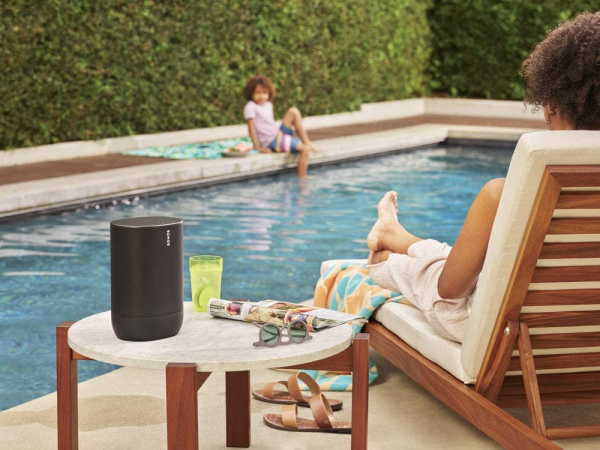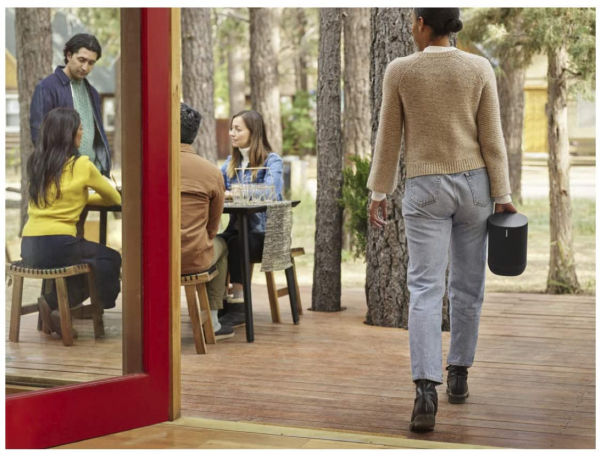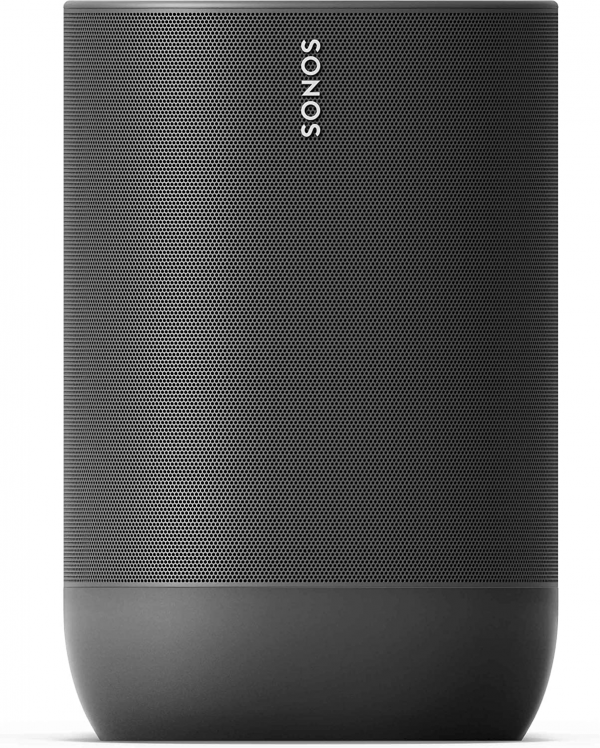Sonos
Sonos Move: a versatile and robust transportable speaker
Aprox. 399€ - see price -
See specificationsWith the Move, the Sonos multiroom specialist finally has a portable Wi-Fi and Bluetooth speaker in its catalog. This imposing model promises us a rock-solid robustness and an exceptional sound rendering. Let's see what it is ...
Positive points
Very deep and well balanced bass.
Very neat and robust design (IP56 certification).
Easy access to the speaker battery / removable battery.
Intuitive and pleasant handling, excellent multiroom system.
Bad points
Perfectible management of the distortion which prevents from exploiting the good reserve of power.
We would have appreciated better precision, even at low volume, and better definition in the treble.
No mini-jack input.
Weak autonomy.
Our review
Presentation
Specializing in sedentary speakers and multiroom, Sonos created the surprise at the start of the 2019 school year by announcing its first transportable wireless speaker. Wireless speakers are popular, but there are still very few models combining Wi-Fi, multiroom and Bluetooth in a transportable format (and therefore with battery). There is therefore a game to play for Sonos. The Move also tries to stand out with its rugged design, its compatibility with voice assistants and its automatic TruePlay calibration.
If not its cooperation with Ikea for Symfonisk speakers, Sonos is not known to be aggressive on the price. The Sonos Move is therefore launched at € 400.
We tested the speaker in version 1.25.1.7-2 with an application in version 10.4.2.

Ergonomics
The speaker retains the aesthetic codes of the American brand, with a very refined appearance, close to the One, for example. The quality of manufacturing and finishes is truly there. The plastic used on the chassis of the enclosure seems particularly robust and thick, just like the grid which protects the reproduction system. The lower part of the enclosure is covered with a non-slip rubber coating. It holds very well in place once installed. Its robustness is verified in practice, with excellent resistance to shocks, small drops and especially to water splashes and dust. The Move is IP56 certified.
Sonos signs here its arrival in portable audio. That said, with its size of 16 x 24 x 13 cm and more than 3 kg on the scale, this speaker is clearly not a paragon of compactness. This is indeed a transportable enclosure. To facilitate its transport, precisely, the design of the Move incorporates a very easily accessible handle. For the most careful, a flexible fabric pocket is also present to protect the chassis from possible scratches.
Having already welcomed Sonos products in our labs, we very quickly took our brands with the Move. The start-up of the loudspeaker, the light / sound indications and the control possibilities are very close to models like the One or the Beam, for example. Neophytes are not left behind since the handling is relatively intuitive. The first configuration is also very simple and quick, just follow the steps via the Sonos app. Interaction with the Move is regularly punctuated by sound and light alerts, but it is true that we would have appreciated some vocal indications (native, not linked to Alexa or Google Assistant intelligent assistants, moreover both supported by the Sonos system and the Move).
All essential controls (management of playback, volume, navigation between tracks) are present directly on the speaker (three sensitive touch buttons). The orders respond perfectly well. There are also two physical buttons on the back of the speaker. The first allows both to select the wireless connection mode (Wi-Fi / Bluetooth) and to start pairing. Note also that it is impossible to take advantage of Bluetooth and Wi-Fi connections at the same time. In Bluetooth, it is therefore necessary to make a cross on the connected functionalities (multiroom, intelligent voice assistant, TruePlay calibration…). The second button simply turns off and on the speaker: something that may seem anecdotal, but never seen before at Sonos.
Sonos promised the Move 10 hours of autonomy. Even if the promise is kept and some direct competitors do not necessarily do better, it remains low compared to most portable Bluetooth speakers. In addition, this data can quickly drop if we set ourselves to a generous listening volume (around 60 to 70% of the maximum volume). Note, however, that the speaker can stand 120 hours out of its base when it is in standby. What's more, the battery is relatively easy to access and it's very easy to remove. It only remains to wait for Sonos to make available batteries on the market. In any case, this is excellent news for the life of the enclosure.
Communication latency in Bluetooth is slightly above the average of portable speakers. You will be able to perceive a small difference between sound and image in this connection mode. In the best of cases (mobile application automatically applying a certain compensation), you will be able to follow your audio / video content without too many problems, but not in absolute comfort.

Multimedia
We're starting to get to know the current Sonos ecosystem and application, which hasn't seen any real change since the launch of Sonos One at the end of 2017. After all, we don't change a winning formula: it is still the best in the world today, both for its completeness and for its remarkable ease of use.
From the initial configuration, very carefully guided step-by-step guidance ensures that a novice can start the system. Subsequently, managing the multiroom (grouping of speakers, individual volume settings) is just as intuitive. Only slight concern that can be noted: in their business of simplifying the basic interface, the designers of the application were forced to relegate to submenus some useful features (such as adjusting the bass level and treble). It is certainly little compared to all the qualities.
Finally, the Sonos system is distinguished by the crazy amount of music streaming services with which it is natively compatible. There are absolutely all the popular services: Spotify, Deezer, Google Music, Amazon Music, Qobuz, Tidal, and even Apple Music via the AirPlay 2 broadcast protocol. Cherry on the cake, the search function integrated into the application is capable of producing unified results from all these services. A real joy!

Speech Recognition
The voice recording part of the Sonos Move is provided by 4 microphones that can be seen on the upper part of the speaker. They are only active when the speaker is connected to the local network and in Wi-Fi mode. They can be deactivated at any time using a dedicated button. As mentioned above, the Sonos system is compatible with Google Assistant and Alexa. If we put aside the difference in power of the assistants' detection and analysis algorithms, the speaker provides a very satisfactory quality of capture with the two services.
The microphones perfectly pick up voice and requests in a calm environment, even several meters away, or even in a neighboring room. You don't have to speak very loud to be understood. When the speaker is playing music or in a slightly noisy room, remember to place yourself in the same room as the speaker, but the trigger does not require you to speak particularly loud. No problem to address the assistant at high listening volume, just get close and speak out loud and intelligible. That said, it sometimes happens that the trigger is a little more finicky or that it is necessary to repeat more often certain requests than with the best models on the market.

Audio
The Move is equipped with a mid / bass speaker and a tweeter for monophonic sound reproduction. The internal architecture is a bit special since the manufacturer has chosen to tilt its tweeter down to “ensure wide distribution of high frequencies”.
It really does not jump to ears when you start using the speaker. Indeed, the Move shows above all a great affection for low frequencies. Without direct user intervention (which goes through the two-band EQ present in the application), the bass is always well in front, thus giving a very warm sound rendering. That said, there is a balance in this region of the spectrum, especially with the activation of automatic TruePlay calibration. The bass is rather well defined, relatively punchy and they are deep. The extension in the bass extremes is generous since the Move attacks the reproduction from 40 Hz. We thus feel the impact coming from the bass and we benefit from a good seat. To gain readability on certain songs (very rich in sources, with very little dynamics) and obtain a more balanced and clearer overall rendering (especially indoors), do not hesitate to reduce the bass by a notch or two and boost the treble a notch with the equalizer of the application. Also remember to deactivate the “Loudness” mode.
The very warm sound rendering offered by the Move is mainly due to a wide and marked withdrawal from the high-mids to the extreme treble. The balance in this region alone is more than adequate, but the accuracy is not incredible, especially when you start to push the volume. This loss of precision is accompanied by a reinforcement of the brilliant aspect of the treble, which one can also qualify as scintillant according to the songs listened to. What's more, even with the help of the EQ, the sound reproduction still lacks a bit of air and detail in the treble. The increase in power also has an impact on the bass precision because, here again, of a perfectible management of the distortion below 150 Hz. This results in more boomy bass and mask effects on the higher frequencies.
Given this, it is not possible to exploit the power reserve of the Move, as generous as it is in terms of its size. In practice, you should not exceed 60 to 70% of the volume to maintain good listening quality and limit the harmful effects of distortion. Under this threshold, we are still able to sound a living room of a very correct size (about 20 m²) or an outside, a terrace, about ten meters from the enclosure. The amplitude of the diffusion of the speaker alone is not extraordinary, and it is felt outside. It will be necessary to opt for a couple of speakers to hope for a correct immersion in the desired listening area, which will increase the bill.

Conclusion
Let's face it, the Move isn't the best model if you're looking for a “classic” portable Bluetooth speaker. Although it is relatively powerful and very robust, it does not offer any wired connection and its autonomy is far behind that of the best on the market. On the other hand, its connected part (multiroom, AirPlay 2, compatibility with voice assistants, etc.) is the most developed and the most intuitive to date, thanks to the Sonos system. It is therefore intended for users who wish to both enlarge their Sonos fleet and take advantage of the advantages of a transportable speaker, and also to those who want to discover the joys of the Sonos multiroom without limiting themselves to a sedentary speaker. You can also take a look at the Zipp 2 (more possibilities of wired connections, much less robust ...) or the Link 20 (more compact, much softer price, Chromecast only ...), which are for the only real direct competitors of this Move.

Specifications
Reviews


The best SONOS speaker ever!
I have to admit that I am a longtime fan of SONOS, although I do think that I have dealt my share of constructive criticism over the years. When it comes to the SONOS MOVE, I think they have made a home run!
Here is what I like:
1. It sounds amazing! Here's why - The bass is significant, even outside, without ever getting distorted. It plays really loud if you want, but also sounds well balanced at low sound levels. They did something amazing with the high-frequency and mid-range where is sounds uniform across the entire side and forward projection of the speaker, not just in the "sweet spot" in front like other speakers. It is beautifully detailed and realistic sounding.
2. It looks great. Here's why - It has the same great looks as I have come to expect from SONOS, but there is something about the material choices on this product that make it even better. It fits right in with my other SONOS speakers, while not taking up any more space than say a SONOS ONE.
3. Automatic Trueplay - it automatically adjusts its sound depending on where you place the speaker, making sure that it always sound its best. I imagine this was pretty had to do, but it works really well. I put MOVE in some pretty challenging places inside and outside, and within 20 or 30 seconds or so it just fixes itself and sounds great again!
4. The WiFi range - I took MOVE outside and began to walk all around the outside my house and into the yard pretty far away and it never lost connection. SONOS did something special here with the WiFi to make it super robust.
5. Bluetooth - even if you go some place without WiFi, you can still connect with Bluetooth. I like having that feature so that I don't have to worry if there is WiFi or not wherever I might travel.
6. It feels solid - It has a great solid and balanced feeling to it. There is an integrated handle in the back that is just part of the design. I've set it down on sand and grass and it just feels stable and balanced.
7. Stereo pair - I only have one, and with it I can fill my whole yard with incredible sound, but I like knowing that if I ever got another one, I could set them up as a stereo pair and have myself a real outdoor concert!
8. It's weather proof - you could get caught in the rain, or it could get dirty and you can just rinse it off with a hose. I plan to take good care of MOVE, but its nice to know that it has this level of protection from the elements.
9. It has voice control - just like the SONOS ONE, it has a microphones that allow you to use Alexa and Google voice assistants. That comes in handy, especially when you are outside grilling.
10. Charging base - it comes with a nice charging base, instead of it being sold as an accessory like other brands do.
What I don't like:
1. Travel bag - it comes with a nice looking bag, but I question how long it will last and how much protection it will really give. I'm sure SONOS will offer a travel bag accessory at some point, but for $ 400, it seems like they could have included a nylon padded bag with handle and pouch for accessories.
2. USB-C charger - it is great that it comes with a nice charging base, but if they made the charger a detachable USB-C charger, then you could more easily take it with you when you travel. I'm sure SONOS will probably sell a USB-C charger accessory at some point, but again, for $ 400, I think this could have been included.
Overall, this is one fantastic product. I would say that this is easily the best SONOS product they have ever made. I just love having a "truly wireless" wireless speaker!
Outstanding outdoor speaker and indoor Play 3 replacement
Finally, at long last ..... we finally have an outdoor, portable, Bluetooth / wifi Sonos speaker offering. I have Sonos products all over my house, so I will admit I already like their products and I am very familiar with them. This speaker fits perfectly into their lineup for people who want to be able to bring Sonos away from home wifi zones. I'll make this review short and sweet. This speaker is not small .... it's probably about twice the volume of a Play One. It's also not light, but it comes with a very well-designed handle. The way I think of this speaker is a new and improved Play 3 that happens to be mobile and battery operated. It has a front-facing driver that sounds very nice and is plenty loud for my taste. It can be paired to another Move speaker if you have a large deck and you don't want to hardwire a stereo setup.
What I do with mine is the perfect application, in my opinion. I leave the handy and well-executed charging station where I would have placed a Play 3 in my house. It will operate exactly the same as your other Sonos speaker. When I'm going to use it outside, I simply pick it up and take it with me. The internal wifi extenders means I never have to use Bluetooth when I'm anywhere near my house. I use this on my deck. If I forget to bring it in at night, it will have no issues with a rain storm, a drop into the pool, or a water gun blast.
Pros:
- Solid speaker loudness and tone. It's not as good as a Play 5, but as good or slightly better than the Play One.
- Very well built.
- Charging station is nicely done and can remain in a convenient location.
- Can be charged with any USB-C plug as well.
- 10 hour battery life at 50% volume.
Cons:
- Price. This is not an inexpensive speaker.
- Size and weight. I don't take this to the beach with me. It's a little too big for that and I wouldn't want to risk something of this value at the beach.
- It's new, so there are not any aftermarket wall or deck mounts being made yet. I am waiting for a wall-mount for my deck where I can just set it down out of the way.
Finally! Sonos delivers a wireless speaker!! Best of all It checks all the boxes.
Portable (Check), pairable (check), weather resistant (check), Trueplay (check), voice control (check), bluetooth (check), Sonos sound and of course WiFi capability, (Check and Mate). This really is an amazing speaker. If you own a Sonos system it's a great adjunct. I now have 19 Zones with my new "Move" speakers including three Zones in my yard. The "Move" is the speaker I've been hoping that Sonos would make. Every situation is different but I'd highly recommend getting a pair of them. Everything sounds better in stereo. Enjoy and thanks Sonos for making life just a little bit better.
High-quality, somewhat portable sound
My old bluetooth speaker blew out, so I decided to upgrade to the Sonos Move. Obviously, it's pricey. But with that price comes a sound quality I didn't expect from a portable speaker. Audio is rich and clear. Bass is deep enough, but noticeable better in smaller quarters.
The build quality is what you'd expect for the price. The charging ring-type stand is a nice touch. And speaking of touch, the touch controls on the top of the unit are responsive with a light tap.
When it comes to portability, it fell like carrying a gallon of water around. Carry this around in a backpack and be ready to sweat. It does come with a soft felt fabric bag which is only good for keeping dust and debris off the unit. If you plan on taking it places, get a case.
The Sonos Move is a solid buy if you want to splurge.